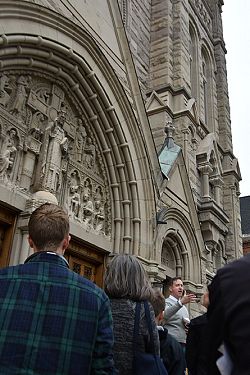Architectural expert explores the Cathedral of the Madeleine during tour

SALT LAKE CITY — Most people who visit the Cathedral of the Madeleine are struck by the beauty of the building and are aware that it contains a great deal of symbolism. However, few realize that almost every architectural element reflects Scripture or Church teaching.
An April 5 tour by Dr. Denis McNamara, renowned Catholic architectural historian, highlighted the architecture, ornamentation and symbolism of the cathedral.
Beginning at the main entrance, McNamara explained that the exterior of the building signifies the mystical body of the Church. On the façade, Christ is portrayed surrounded by human beings, including the 12 apostles, several Doctors of the Church and representations of the Four Evangelists: Matthew, Mark, Luke and John.
The outside represents the fallen world; the image of Christ carved at the cathedral entrance represents that it is he who will determine who is worthy to enter the city of heaven, McNamara said.
The narthex (antechamber) just inside the door represents “the transition from the noisy fallen world to anticipating heavenly glory,” McNamara said.
Although the cathedral is beautifully painted with many images representative of the kingdom of God, even the simplest elements speak to His glory, he said.
In its ornamental patterns and gem-like colors, the cathedral harks back to the Temple of Solomon, he said.
The columns that hold up the building symbolize people, the “pillars of the Church” who support the Church, or the 12 tribes of Israel, McNamara said. The angelic beings painted on the ceiling indicate that angels worship with the faithful and represent “the cosmic dimension of liturgy,” McNamara said. “Angels are not just old-fashioned stuff; they are part of worship and assembly, the nature of liturgy.”
Often unnoticed by worshippers are the golden figures at the base of the ribs of the cathedral’s main arch. Those figures are “the Four Evangelists holding the Church up; heavenly beings that meet the liturgical architecture of the Church and hold it up,” McNamara said.
The great mural behind the altar with the crucified Christ at its center represents the “full rich notion of what heaven might be like,” he said.
In the mural, God the Father is portrayed holding the cross in symbolism of faith holding the Savior’s eternal offering. Mary Magdalene, the patron saint of the cathedral, is shown beneath the cross, representing the saint’s intercessionary role between earth and heaven.
From the “garments of salvation” the saints of the Old and New testaments wear to the stars as depicted as almost-flowers, in the mural each element represents the eternal glory that all creation will be blessed with at the end of time, he said.
Every aspects of the cathedral’s interior works together with the others to enlighten the faithful, he said.
The interior style of the building, designed by John T. Comes in 1917, was inspired by a love of the architecture of the Middle Ages, McNamara said.
“In the mid-19th century, many in the Church fell out of love of the architecture of their time,” he said. “A lamenting of the beauty of the Middle Ages was at its height at this time.”
The 1991-1993 restoration of the cathedral, which restored it to its former glory after several decades of use, was “one of the most sensitive, carefully nuanced renovations of its time,” McNamara said.
More than 50 people participated in the tour led by McNamara.
“I learned more in that hour than I ever heard before,” said Deacon Lynn Johnson after the tour. “He brought it up to a whole different level than before.”
Deacon Johnson often leads private group tours of the cathedral.
McNamara has written several books on Church architecture, and co-founded the Liturgical Institute at Mundelein with Msgr. M. Francis Mannion. He was in town to present a talk at St. Catherine of Siena/Newman Center as part of the parish’s Liturgical Renewal Initiative.
© Copyright 2024 The Diocese of Salt Lake City. All rights reserved.

Stay Connected With Us